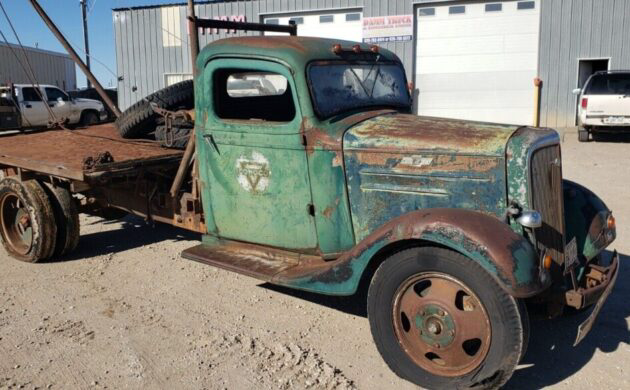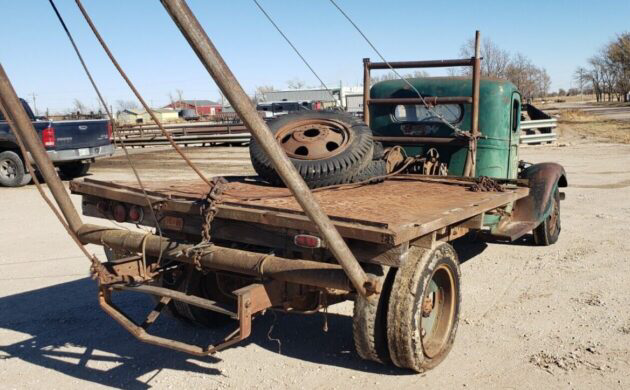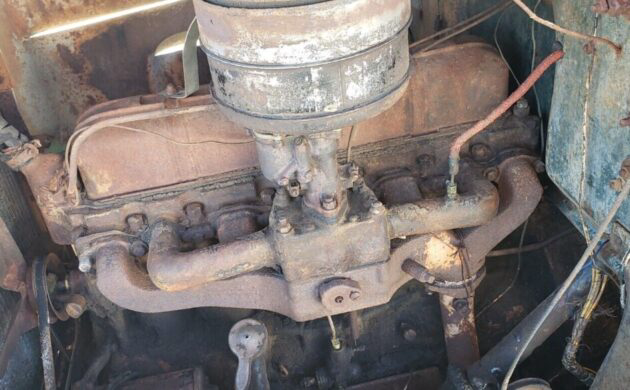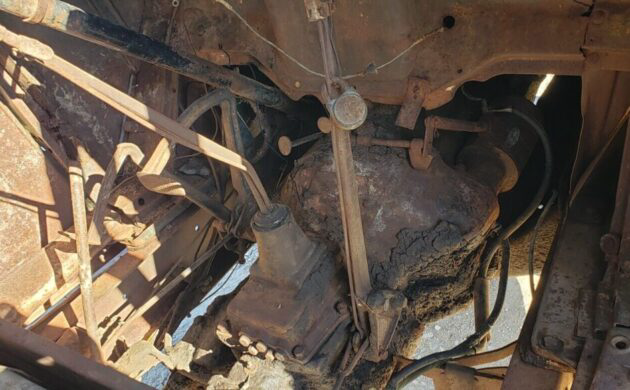Chevrolet and Ford both have produced a wide variety of trucks over the years for both personal and commercial use. This 1936 Chevy appears to be a 1.5-ton stake truck (without the wooden slats). Once in service to a Conoco gas station (perhaps as a tow truck), this transport looks to have been sitting for many years and the motor is stuck. Yet, rust doesn’t seem to be a huge problem. It has a great patina, but its purpose these days might better be to serve as advertising or man cave decorations. Located in Great Bend, Kansas, this old Bow-Tie is available here on eBay for $3,150, though offers will be considered. Our thanks to Larry D for his continued persistence in the tips department!
Assuming the stake truck angle is correct, these trucks were available with 131 or 157-inch wheelbases, depending on your cargo-hauling needs. This one seems to be the latter, which would have afforded 80 square feet of working space before the winch and poles were added. I’m not sure what the poles would be used for, but we’re told they can be lowered easily and/or removed for transport (the seller says he has the equipment to do so). Since the Kansas license plate is dated 1955, we’re wondering if that’s the last time this truck was used. The seller was told it was running when parked, but that was possibly a generation ago.
Under the hood resides a very rusty and dirty inline-6 inch which is likely 216 cubic inches in displacement, if original. There’s no telling whether you’d want to attempt a rebuild or just drop a newer motor in its place. A heavy-duty manual transmission is there, but no mention is made of whether you can run it through the gears while parked. For more details on the trucks that Chevy built in the 1930s, check out this brochure.
Surface rust (aka patina to collectors) is rampant but likely not much worse, meaning a cosmetic restoration wouldn’t be an endless money pit. The doors sag when opened, indicating that new wood is needed behind the A-pillars. The cab floor is missing but can be had on eBay for under $150 (according to the seller). The Conoco brand on the doors is a further throwback to yesteryear. They were an American oil and gas company that operated for 137 years to 2002, at which time it merged with Phillips Petroleum to form ConocoPhillips.






You won’t hear much from me anymore (7th notice), I may be FOS sometimes, but at least I contribute without swear words cleverly disguised with catchy symbols to skirt the filter and try to promote the site, and help the writers, if I can. This is not a tow truck, but a pipeline hoist truck. The pipe sections would be stacked on the rear platform, and raised via the pole hoist and set in the hole. I better keep this short, or some may think I’m “on something”. “Crusty ramblings, indeed”,, :),,no wait,,,:(,,, you won’t get rid of me that easy, I enjoy the site, and the writers, the rest of you can cram it with walnuts.
Once again, I apologize, obviously, not all should “cram it”. Thanksgiving, ironically, is just the worst time for me. What may appear to be “crusty ramblings” to some, I hope makes perfect sense to others. I’m just an old guy upset how the cookie eventually crumbled with this hobby. Peace, eh?
Crusty Ramblings are a perfect Holiday Season feast at most BF tables in would think, Howard-especially in some cases (my own in particular) where I may have to eat my words..!
Happy Holidays, my friend and all our other friends here at BF!
Howard, don’t get your knickers in a knot again. I always read what you write and do find your commentary very informative.
Don’t be so self-defensive when criticised by commentary. Car guys are like that.
You are a regular commenter that I always search for to see what you are saying about whatever car we are looking at. Don’t forget that everybody is different and has a different outlook.
If you are going to mope around then you’re being too idiosyncratic.
We’re talking cars n’ bikes n’ old trucks.
Bob
With WALNUTS!!! you’re the best, sir!!!
LOL. Cram it with walnuts? Reminds me of my late uncle Mike, God rest his soul. I don’t know exactly how old you are sir, but that comment puts me in mind of the era I feel like I should have been born in. Hand written letters (in cursive), unlocked doors, yes sir and no ma’am. EG: Leave it to Beaver. Keep ‘‘em coming Howard!
Hmm, “Crusty Ramblings”,,at first I was offended, but now, that could work, a column about a pizzed off old guy pertaining to todays car hobby,, thanks to most, and especially to those that understand my views.
Also, thanks for the “gin pole” reference. I had to look that up, what a “gin pole” was. It’s simply a lifting device for jobs taller than a backhoe could reach, and reason I said oilfield pipe truck, is trucks like this lifted pipe casings, or dropped them in the hole. Conoco lettering probably what this was for. “Crusty Ramblings”,,,I like it! Thanks, CC,,
Honestly Howard you should have your own column, “Crusty Ramblings” good name for it. I for one really enjoy your posts. I’m not really an old guy yet (just 64) I feel the same way about some of these prices. I remember passing over a ’57 Belair and ’62 Impala for $100 bucks each both drivers in so so shape and about 20 years ago a ’63 Galaxie 2dr sedan w/ 30,000 on the clock for $1000. I know things cost more now but is anybody really paying 20 grand for a rusted out hulk in somebody’s backyard? The price on this one is fairly reasonable but someone’s gotta want a big truck.
Howard,
You’re going all “curmudgeon” on us😆
I think Howard is correct, this is clearly not a wrecker. Though I was thinking utility pole hoist
Pole hoist truck in Kansas in 1938
https://www.kshs.org/km/items/view/294
I worked a summer in Hayes, Kansas during college on an oilfield “roustabout” crew. Early in the 1980s and we had an early 1970s similar bed truck. It was called a “gin” truck. No idea why.
Given my oilfield background, this also was my first thought, “that’s a gin pole truck.” You can reference Wikipedia for more information, including history of the term.
Awwwww What the H? Lol!
I like the finish on this one, but I think the seller set the price a little low. If folks would just try to live in the present, they might be happier, and they might not be so butt hurt that they sold their classic for next to nothing.
Jolly Joe, It’s a gin pole setup, is why they called a “gin” truck.
Why did they call the pole a gin pole though? I’m sure I could google it but what’s the fun in that?
Heard that this one was seen in the parking lot at SEMA but they couldn’t get it inside for paint and horns because the boom was too high. Had to rely on genuine patina. Surprised with the originality Dave still liked it
LOL! Nice one!
Would be a fun toy to take to car shows in my area
That grill is in nice shape. A work truck like this can be a nice do-it-yourself project. The sheet metal is thick and can tolerate a lot of amateur body work. Perfection isn’t required. Minimal chrome to replace.
Everyone is correct about this being a gin-pole truck. They were used for general lifting work in the oil fields until the 1970s when hydraulic picker trucks became available.
This is likely an early version. The ones I’m familiar with (1960s), would loosely pin the poles (usually 2″ pipe) at the back edge of the deck such that they could be rotated forward and rest on the headache rack behind the cab when moving between work sites. An “A” shaped fitting with a pulley would socket on to the upper ends of the pipe/poles. With the poles resting on the headache rack, the pulley fitting could be slid off the poles, and the poles manually lifted off the headache rack and laid in channels on either edge of the deck (but still pinned to the rear edge of the deck) to further reduce clearance height and to make deck space available for equipment hauling.
The rear edge of the deck would often have a “live roll” (6″ pipe in bearings) so that the winch could be used to pull skid-mounted equipment up and on to the deck for hauling between sites. A “fifth wheel” could also be mounted on the deck and the front of a trailer could be lifted up and winched into position on the fifth wheel. Equipment would have been loaded on to the trailer by laying the front edge of the trailer on the ground (like a ramp) aligned with the load and positioning the winch truck against the back edge of the trailer and running the winch cable over the railer deck and connecting to skids under the load. With the gin poles raised, the truck could be used to unload or load pipe or other assemblies off the sides of semi-trailers hooked on to their highway tractors.
Overall, this would be a nice project and a nice conversation starter at show and shnes.
I found this ’38 Chevy wrecker behind an old antique store a couple of decades ago. It has a Weaver Power Auto Crane wrecker unit that came with a gas engine that powers the 2 winches. It is an original single rear wheel 1 1/2 ton with the full length running boards. I found a pair of NOS (!) rear fenders for it and am dealing on 1 NOS front fender. Still need a decent original grill, have 3 that I can piece together, but would love to find a really nice original. Probably will update the power train but will stay with a six and a manual trans. I’m retiring in a couple of months and have 4-5 projects like this I’d like to complete.
Very cool indeed. Post more photos when you can get ‘er out on the road!
The wheel offset and axle sticking out makes me think it should be duals.
I have a Holmes 515E wrecker with no body, only remants of the floor with the old style diamond plate. I think you’re lucky to have that body and finding NOS fenders is amazing
Howard, I also enjoy your comments. I’m probably around your age and sometimes I have to just shake my head in disbelief at the asking price for some of the stuff on BF. But I guess there are folks who are willing to pay the ask. So be it. Please keep your observations coming. It’s a great part of this site to read what others think.
At the risk of offending the purists in our group which sometimes includes me, I have known a couple of trucks this size whose cab & sheetmetal were transplanted to a modern 1 ton Chevy chassis complete with 454/auto drive train. I grew up driving trucks like these on the farm and they aren’t nearly as much fun to wrestle around as a like year car or 1/2 ton truck. Nor after a time consuming restoration to whatever degree, are they as valuable. :-) Terry J
Can you say split rims?!! Buyers be careful, It would fit perfectly in the fleet,afraid my wife would make me live in it.
Keep up the good work, Howard. Your info and experiences are are much appreciated, specially by us old guys. The Conoco sign on the doors give away the true history of this oilfield truck. Today you can see many modern cab trucks motoring around Farmington, NM oil fields with the same gin pole setups, doing the same work this old girl did. Good honest truck, deserves to be cleaned up and used. Thanks for the detailed explanation, Andrew. It helps others understand the work these trucks did and do.
Interesting and appreciated comments from all of you Barn Finders, Howard included. Now that I think we have sorted out what this truck is and is called, one more tidbit:
I remember my dad saying he had “ginned up” something. He meant he had created it, or fashioned it, or fabricated it, or improvised it. Usually with a connotation that he had done it with scrap pieces and/or in a poor-boy fashion. I think I’ve even used the term at times. Anyone ever say you “ginned up” some piece of equipment?
This truck is surly from a pipe line company. They were used for many purposes like moving sections of pipe, moving “Skids” that sat under pipe being worked on, and other light lifting jobs. We always called them a “boom truck”.
The booms were made to lay forward by using the winch and pully blocks to lower the booms forward for long distance travels.